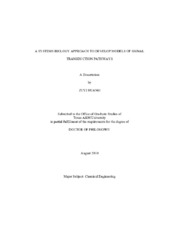| dc.contributor.advisor | Hahn, Juergen | |
| dc.creator | Huang, Zuyi | |
| dc.date.accessioned | 2011-10-21T22:03:00Z | |
| dc.date.accessioned | 2011-10-22T07:09:48Z | |
| dc.date.available | 2011-10-21T22:03:00Z | |
| dc.date.available | 2011-10-22T07:09:48Z | |
| dc.date.created | 2010-08 | |
| dc.date.issued | 2011-10-21 | |
| dc.date.submitted | August 2010 | |
| dc.identifier.uri | https://hdl.handle.net/1969.1/ETD-TAMU-2010-08-8328 | |
| dc.description.abstract | Mathematical models of signal transduction pathways are characterized by a large
number of proteins and uncertain parameters, yet only a limited amount of quantitative
data is available. The dissertation addresses this problem using two different approaches:
the first approach deals with a model simplification procedure for signaling pathways
that reduces the model size but retains the physical interpretation of the remaining states,
while the second approach deals with creating rich data sets by computing transcription
factor profiles from fluorescent images of green-fluorescent-protein (GFP) reporter cells.
For the first approach a model simplification procedure for signaling pathway
models is presented. The technique makes use of sensitivity and observability analysis to
select the retained proteins for the simplified model. The presented technique is applied
to an IL-6 signaling pathway model. It is found that the model size can be significantly
reduced and the simplified model is able to adequately predict the dynamics of key
proteins of the signaling pathway.
An approach for quantitatively determining transcription factor profiles from GFP reporter data is developed as the second major contribution of this work. The procedure
analyzes fluorescent images to determine fluorescence intensity profiles using principal
component analysis and K-means clustering, and then computes the transcription factor
concentration from the fluorescence intensity profiles by solving an inverse problem
involving a model describing transcription, translation, and activation of green
fluorescent proteins. Activation profiles of the transcription factors NF-κB, nuclear
STAT3, and C/EBPβ are obtained using the presented approach. The data for NF-κB is
used to develop a model for TNF-α signal transduction while the data for nuclear STAT3
and C/EBPβ is used to verify the simplified IL-6 model.
Finally, an approach is developed to compute the distribution of transcription factor
profiles among a population of cells. This approach consists of an algorithm for
identifying individual fluorescent cells from fluorescent images, and an algorithm to
compute the distribution of transcription factor profiles from the fluorescence intensity
distribution by solving an inverse problem. The technique is applied to experimental data
to derive the distribution of NF-κB concentrations from fluorescent images of a NF-κB
GFP reporter system. | en |
| dc.format.mimetype | application/pdf | |
| dc.language.iso | en_US | |
| dc.subject | Green fluorescent protein (GFP) reporter systems | en |
| dc.subject | Fluorescent microscopy image analysis | en |
| dc.subject | IL-6 signaling pathway | en |
| dc.subject | Inverse problem | en |
| dc.subject | K-means clustering | en |
| dc.subject | Model simplification | en |
| dc.subject | Mathematical modeling | en |
| dc.subject | Observability analysis | en |
| dc.subject | Principal component analysis | en |
| dc.subject | Sensitivity analysis | en |
| dc.subject | TNF-α signal transduction | en |
| dc.subject | Transcription factor profiles | en |
| dc.title | A Systems Biology Approach to Develop Models of Signal Transduction Pathways | en |
| dc.type | Thesis | en |
| thesis.degree.department | Chemical Engineering | en |
| thesis.degree.discipline | Chemical Engineering | en |
| thesis.degree.grantor | Texas A&M University | en |
| thesis.degree.name | Doctor of Philosophy | en |
| thesis.degree.level | Doctoral | en |
| dc.contributor.committeeMember | Datta, Aniruddha | |
| dc.contributor.committeeMember | El-Halwagi, Mahmoud | |
| dc.contributor.committeeMember | Jayaraman, Arul | |
| dc.contributor.committeeMember | Laird, Carl | |
| dc.type.genre | thesis | en |
| dc.type.material | text | en |


